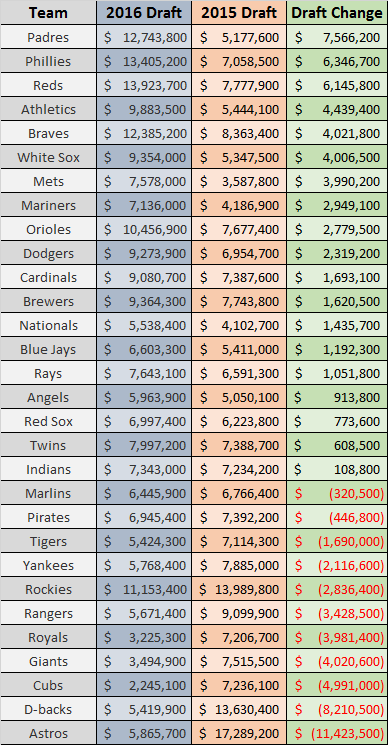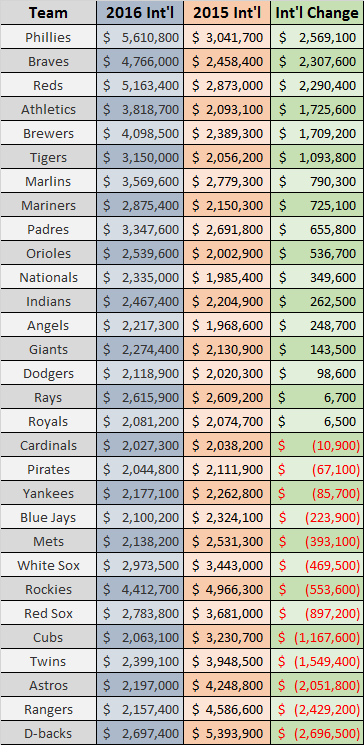Baseball America’s Hudson Belinsky reports that draft and international spending pools will rise by about 4.6 percent in total for the 2016 Rule 4 Draft in June and the 2016-17 international signing period, which kicks off on July 2. Belinsky provides total draft and international pools for all 30 clubs, with the Reds ranking first in terms of draft bonus pool at $13.923MM and the Phillies laying claim to the top international pool by virtue of finishing with the league’s worst record in 2015.
For MLBTR purposes, I’ve compiled quick references highlighting the year-to-year changes in each club’s draft and international spending pools, although it’s important to stress that the draft pools are still highly subject to change; Ian Desmond, Dexter Fowler and Yovani Gallardo all remain unsigned and will all require a club to forfeit its top unprotected pick upon signing, while the Nationals, Cubs and Rangers will all receive comp picks in exchange for those losses (Links to draft changes table and to international changes table for mobile app users).
Notably, that means that the Orioles’ current projection of a $10.457MM bonus pool is likely due for a precipitous decline, as the team has been rumored to be nearing a deal with Gallardo for nearly a week. While the exact value of the No. 14 overall pick that Baltimore would surrender isn’t known, last year’s 14th overall selection carried a value of $2,842,400. A 4.6 percent increase in that figure — the number referenced by Belinsky — would result in a slot value of $2,973,150. That figure would completely negate Baltimore’s $2.78MM pool increase, and the O’s could stand to incur further draft losses if they complete a deal with Gallardo and go on to pursue Fowler, as has been rumored. Baltimore’s second pick, No. 29 overall, would rise to 28th overall in the event that a deal with Gallardo is completed. Again, based on last year’s $1.975MM value for that slot and a 4.6 percent increase, the Orioles would stand to lose $2.066MM in draft money, bringing their total loss in the event of those rumored signings to $5.039MM — roughly 48 percent of their overall pool.
While the Reds have the largest draft pool overall, it’s the Padres who saw the largest increase in their draft spending potential, as the team received compensatory picks for the departures of both Ian Kennedy and Justin Upton in addition to winning the first pick in Competitive Balance Round B, which sits at No. 71 overall. As Belinsky points out, that gives San Diego six picks in the top 85 of the upcoming draft (so long as the club does not sign one of the aforementioned free agents, which indeed appears unlikely).
Conversely, no team has seen as swift of a fall in its draft spending potential as the Astros, who went from an enormous bonus pool of more than $17MM to a more standard pool of $5.866MM. (Last year, Houston picked second, fifth and 37th overall in the draft, thus creating the record-setting bonus pool.) The D-backs lost more than $8MM in pool money due to the fact that they dropped from the No. 1 overall pick to the No. 16 pick and subsequently forfeited the pick anyway to add Zack Greinke.
The Cubs punted a pair of picks to sign Jason Heyward and John Lackey, though they’ll see a notable bump back up the rankings when they receive a comp pick after Fowler signs (that comp pick between the first and second rounds will be eliminated due to the Heyward/Lackey signings, but Chicago’s second-round pick will then be restored, adding about $920K to its pool). Similarly, the Nats and Rangers will each see their draft allotments jump north of $7MM once Desmond and Gallardo sign.
Meanwhile, the Phillies enjoy the largest increase in baseball on the international side of the equation, although the size of their pool could be rendered moot if the team exceeds its cap by a wide enough margin. Philadelphia is reportedly planning to be aggressive, and if the team plans to incur significant penalties, then the only real gain from the top pool is a bit of a break on luxury taxation. As such, if the Phils plan to shatter the pool anyhow, they could actually trade away slots. Counter-intuitive as it may seem, if they’re incurring maximum penalty anyhow, the slots would hold more valuable to a team that isn’t planning to do incur penalties, and the only loss for the Phillies would be more money.
The fact that the Reds are set to receive the third-largest increase again brings to light the team’s curious ties to Cuban shortstop Alfredo Rodriguez in January. Reds president of baseball operations Walt Jocketty denied that a deal was in place at the time that news of a $6MM signing bonus from Cincinnati to Rodriguez broke, and the team has yet to announce a deal. However, if Cincinnati does indeed come to terms with Rodriguez for that sum, it would prevent the team from signing a player for more than $300K in either the 2016-17 signing period or the 2017-18 signing period, thus mitigating the advantage of their notable pool increase. Instead, the Reds would likely trade away their international bonus slots this summer, and while that money can indeed be a deal-sweetener when talking with other clubs, international slots on their own haven’t been traded for much in the way of high-profile prospect capital. Straight-up swaps for international money have previously involved players such as Aaron Kurcz and Garrett Fulenchek. While some of the players in these deals could prove to be solid pieces in the long run, giving $6MM to Rodriguez would mean that the Reds elected to exceed their pool well after the top talent on this year’s international class had signed. Beyond that, they’d be doing it so by signing a limited number of players — highlighted by a defensively gifted but light-hitting shortstop — instead of taking a bulk approach and acquiring multiple prospects in next year’s class.
Looking to other clubs that have incurred maximum penalties, the Royals, Dodgers and Giants are all in roughly the spot in which they entered the 2015-16 period, but those slots will be used as trade fodder this summer after their significant international expenditures over the past seven and a half months. The Yankees, Rays, D-backs, Angels and Red Sox all look like reasonable candidates to trade away the majority of their international slots this coming signing period as well due to the fact that each team incurred maximum penalties in the 2014-15 signing period.


I find it weird that Gallardo, Fowler, and Desmond signing while they are still tied to draft pick compensation is treated as a given when just two years ago both Kendrys Morales and Stephen Drew had to wait to it to expire.
Also, it would have been worth noting that San Diego’s draft allotment was deflated last year by their sacrificing one of the top unprotected picks to sign James Shields.
Gallardo is probably going to the Orioles, but you’re absolutely right about the other two. Desmond has seen declines of between 40 and 60 points of OPS each year for the past four years. Fowler put up career lows in AVG and OBP last year. Both players are uninspiring defensively. Both players are on the wrong side of 30. If I were trading for either player, I certainly wouldn’t be offering a top-five prospect from my farm system as the centerpiece to the deal, and in a deep draft like this one, forfeiting a pick in the first round or a sandwich pick before the second round would be forfeiting a comparable talent.
Agreed. I also wouldn’t sign Gallardo if I was the Orioles management. He could easily implode in Camden Yards. I’d be willing to go as far as saying he WILL have a horrid year in that hitter friendly park. It looks like it’s going to happen but I don’t think it’s good for either side. Gallardo should take a pillow contract on an NL team. Then go back at FA next year with a weaker FA class and maybe no QO tied to him.
Gallardo had a 3.42 ERA last year pitching for the Rangers in a ballpark that has historically been tough on pitchers. Baltimore needs a solid starter NOW….Gallardo turns 30 in a week and he’s had seven consecutive seasons of 30+ starts. No draft pick is going to help them for at least 2-3 years….if ever.
And he has a career 3.62 ERA pitching mostly in the hitter friendly parks of the NL Central including pitching at home in the launching pad of Miller Park, a much more hitter friendly park than Camden.
Statistically Camden comes out as a more hitter friendly park than all but three stadiums. Those being Coors Field, Wrigley and Toronto.
I was mostly just pointing out that guys not getting signed happens, not so much that I don’t think these guys ought to get signed. I do sort of think with Desmond with how sharply he’s been declining, but the other guys I would want.
But something no one else is talking enough about is teams bidding against themselves. That’s what seems to be going on with the Orioles and Gallardo if the reports are accurate. When I said before that I’d want Gallardo, I didn’t mean at the 3/45 the Orioles are randomly throwing at him, much like the contract they handed Ubaldo under similar circumstances.
It’s late in free agency, you’ve waited this long, other teams are mostly done with significant signings, and yet you’re still trying to pay inflated prices? They should offer him something like 8, 12, (13), (14), with the final two years being team options. He can provide good value on a deal like that. Offer it to him and wait. If he accepts, great. If not, then good on you for not giving him a bad contract. Something similar for Fowler, too.
I think cxcx pretty much has this nailed down pretty well. 2 + 1 sounds like a pretty reasonable offer for a guy who obviously doesn’t have a lot of interest right now. I think Gallardo is a decent 3-4 starter and a guy of value for Baltimore. Apparently the O’s think he’s worth talking to and Yvonni may have some difficult decisions to make regarding his future. Maybe his agent just misjudged the market.
That stuff is very interesting. Good job making it at least somewhat understandable.
White Sox are in a great position monetarily, however, their scouting and development staffs are two of the worst in baseball. The organization has really fallen.
I think you have to consider how bad of seasons they guys who waited until the draft pick compensation rule wore off. Being off a half year in baseball is bad for that player and can hurt the team that signs them.
It’s worth noting that the guys who waited in the past to sign after the draft pick rule wore off had horrible years. Taking a half year off in baseball is bad for player and team.
The only player who waited until after the draft to sign was Morales; Drew simply resigned with the Red Sox for the prorated value of the QO.